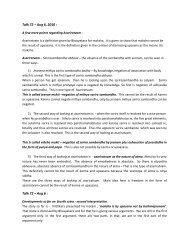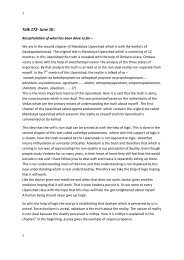Talk 86 – Jan 03, 2010 - arsha vidya kendra trust bangalore
Talk 86 – Jan 03, 2010 - arsha vidya kendra trust bangalore
Talk 86 – Jan 03, 2010 - arsha vidya kendra trust bangalore
You also want an ePaper? Increase the reach of your titles
YUMPU automatically turns print PDFs into web optimized ePapers that Google loves.
<strong>Talk</strong> <strong>86</strong> <strong>–</strong> <strong>Jan</strong> <strong>03</strong>, <strong>2010</strong> :Mantra 8 <strong>–</strong>Soyamadhyaksharomakara…After doing padartha vichara of Omkara, now pada or nama vicara is started. Pada means theword and vicara means analysis. So analysis of the name of the Lord is started and the nameof the Lord is Omkara. When kara is added, it emphasises the sound aspect or letter aspect ofomkara, not the meaning aspect. Otherwise kara itself is not a part of the nama of parmatma.So we should not do japa of omkara. To emphasise the letter aspect, In English and otherlanguages an ‘inverted comma’ is used to indicate kara. In sanskrit we have the conventionof adding ‘iti’ <strong>–</strong> Like Rama iti vada means may you say Rama. Here it goes to the nameRama. That idea is conveyed here by the word omkara.The word Omkara is seen in different ways by different mahatmas. The word omkara iscontaining the message of oneness between jiva and Isvara. This is conveyed in one word -soham. Here the consonants sakara represents Isvara upadhi and hakara represents jivaupadhi. Both are to be dropped because they indicate upadhi. Only makara remains which istaken to be the manifester helping to reveal the svara . What we finally get is AUM. This isnot given in any Upanishad or commentary. This is the way some mahatmas look at omkara.Some mahatmas show another way to look at omkara based on the grammar rules of sandhi<strong>–</strong> the last two vowel alphabets in any varnamala am and ah are present in omkara. In sristiprakriya when we talk about creation, paramatma is looked upon as bindusvarupa or thesubtlest. In ‘am’ the letter ‘m’ is represented by an anusvara or bindu on top. The jiva isrepresented by “ah”. The two dots on the side of ‘a’ are called visargah. Visarga has got themeaning manifestation or projection. So ‘am’represents paramatma and ‘ah’ represents jivawhich is the manifested form of this bindusvarupa paramatma. One mahatma goes evenfurther and says that this one dot of Parmatma when seen in the mirror of antahkarana whichis the reflecting medium will reflect another dot. One dot appears as two dots. So jiva (ah) isnothing but the projection of bindusvarupa paramatma (am). Now they seem to be separate.But when they are united, according to grammar rule then ah + am becomes Om. Akara in‘ah’ becomes’O’ and from ‘am’ only makara remains. Like soham consist of sah + aham.Akara is dropped and ’ah’ becomes ‘o’ and ‘am’ remains as ‘m’. Similarly ah + am becomesOM. So Om is containing the message of unification of ‘ah’ jivah and ‘am’ paramatma.This is not there in any Upanishad, but it is a another way of looking at Omkara by somemahatamas.They further say that suppose this ‘ah’ and ‘am’ are not united by this sandhi ruls, then ah +am becomes aham ie,The same jiva remains as aham. Only if he is united with parmatma ina particular way, then then it becomes Om.The word Om is derived from ‘av ’ dhatu. Avati rakshati iti Om <strong>–</strong> that which protects is Om.That omkara is equated to atma. When atma is looked upon as one whole entity, then it hasgot the name OM.
2But if atma is looked upon as one which is having 4 padas, then omkara is also equated as theone having four matras and each matra of omkara is equated to each pada of atma. This isthe subject matter of the 8 th mantra where the ground is created for further analysis.In the 8 th mantra it was said that atma can be looked upon as adhyaksharam ie, abhidhanapradhanyena <strong>–</strong> it can be looked upon from the standpoint of name. It is adhimatram ie, It issubsisting on matras because matras are padas and matras are padas. Since atma has gotpadas and padas are nothing but matras. Therefore atma can be said to be adhimatram.Grammaticaly the word OM has three matras <strong>–</strong> A,U,M. The fourth matra is called ardhamatra or amatra which will be talked about in the last mantra. So the four padas are equatedto the four matras of Omkara. Like four people have come and they will be occupying fourseats. But the organizer will ask which person will sit in which chair ? There is a protocolnumber for each one and accordingly they are given seat. Similarly the question here will bewhich pada will be equated to which matra. In this matra general statement is made, but inthe next mantra particularizing is done like which pada will occupy which matra..The next mantra is equating the first matra of Omkara- akara to the first pada of atma <strong>–</strong>Jagrita sthanah Vaisvanarah.Mantra 9 <strong>–</strong>Jagaritasthanau Vaisvanaro akarah prathama matrapteradhimatvadvapnoti ha vaisarvankamanadhisca bhavati ya evam vedah.There are three matras A, U and M . Similarly there are three sopadhika padas ie, padas basedon upadhi and the last one is niropadhika pada. The first pada Vaisvanarah is equated toAkara.Vaisvanarah means visvesa naranam samuhah <strong>–</strong>the aggregate of all the beings. ThisVaisvanarah is otherwise called Jagirita sthanah . Jagaritam sthanam yasya <strong>–</strong> One who hasgot waking state as its upadhi. So jagarita sthanah does not refer to the waking state, butrefers to the consciousness conditioned by jagarita avastha. Vaisvanarah is the name given tothis consciousness in terms of totality . It is otherwise called Virat <strong>–</strong> samasti sthula abhimaniatma - The self which is identified with the entire gross universe.In terms of individual waker, it is called Visva. So the akara which is the first part of omkarais equated to the first pada Jagarita sthanah. In other words this upasana is akara pradhanaomkara upasana. The person will be chanting OM and concentrating on the akara of Omkarawhich is equated to the consciousness in the waking state. One has to see the onenessbetween akara and Virat/Vaisvanarah/jagarita sthanah/Visva.To see oneness between the alambana and the upasya there should be some similaritybetween them. Similarly similarity between upasya Vaisvanarah and alambana akara has tobe there.
3Like the role of the king will be played by one who looks bright and confident like a king andnot a timid shy person. Like between shalagrama and Vishnu there is some similarity.( Note : Some info. about shalagrama - Generally this word is mispronounced asShaligrama. There is a lot of interesting sastra on shalagrama and there are many referencesin Puranas to shalagrama.Actually shalagrama is the stone obtained from the riverbed of Gandagi near Nepal. Near theriver, there is a village which has many trees called shala and hence the village is calledshalagrama. The stones obtained from that village are called shalagrama shila. Byconvention this stone should be gifted by somebody and worshipped even if it is broken. Itshould be worshipped with purity with a simple water abhiseka with offering of chandanamand tulsi .The water from bathing the shalagrama is considered to be very sacred.There were 84 types of shalagrama. But nowadays only 14-15 types are found.)So shalagrama is the alambana for Vishnu because it has some similarity to Vishnu. Vishnuhas chakra and each shalagrama also has a chakra in the center.Because of the similarity of having chakra shalagrama becomes the alambana for Vishnu.Like we worship devi as light because both are bright. Or like we worship shiva in shiva lingabecause the linga has a round shape and the round shape is the closest visible form to indicatethat parmatma is fee from all shapes. All shapes are dissolved into round shape. Thereforeshivalinga becomes the alambana for meditating on shiva.Similarly akara becomes the alambana for worshipping on Vaisvanarah because of twosimilarities <strong>–</strong> Apteh and adhimatvam.Apti means pervasiveness. Both akara and Vaisvanarah have pervasiveness. In the thirdmantra, Vaisvanarah was called saptangah - His head is heaven, his eyes are the sun and hismiddle trunk is akasha and his bladder is all water bodies and prithvi is his pada. So he ispervading the whole world. So from samasti angle, Vaisvanarah has apti. From vyasti anglealso there is apti. From the individual angle there are three padas <strong>–</strong> Visva, Taijasa andPrajna. Atma associated with one body - karana sarira is called Prajna. Atma associated with2 bodies <strong>–</strong> karana and sukshma sarira is called Taijasa and atma associated with three bodies<strong>–</strong> karana, sukshma and sthula sarira is called Visva.So atma will have maximum identification ie, it spreads itself the most, when it is Visva. SoVisva has got apti. Without identification with sukshma sarira one cannot think, see or hearwhich are the function of subtle body. And without karana sarira identification, one cannothave identification with the other two bodies. So Visva is having pervasiveness both fromindividual and total standpoint .So Vaisvanarah is aptiman means has apti.Similarly akara also has pervasiveness.









